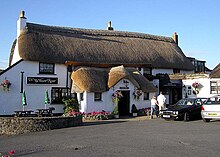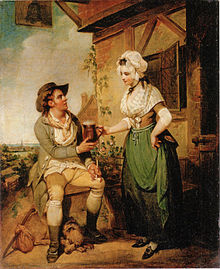A public house, informally known as a pub, is a drinking establishment licensed to serve alcoholic drinks for consumption on the premises in countries and regions of British influence.[1][2] Although the terms are increasingly used to refer to the same thing, there is a definitive difference between pubs, bars, inns, taverns and lounges where alcohol is served commercially. A pub that offers lodging may be called an inn or (more recently) hotel in the United Kingdom. Today, many pubs in the UK, Canada and Australia with the word "inn" or "hotel" in their name no longer offer accommodation, or in some cases have never done so. Some pubs bear the name of "hotel" because they are in countries where stringent anti-drinking laws were once in force. In Scotland until 1976,[3] only hotels could serve alcohol on Sundays. In Wales, an 1881 Act applied the same law until 1961 when local polls could lift such a ban in a district and in 1996 the last ban was lifted in Dwyfor. The need for such polls was removed by the Welsh Assembly in 2003.[4][5]
There are approximately 53,500[6] public houses in the United Kingdom. In many places, especially in villages, a pub can be the focal point of the community, so there is concern that more pubs are closing down than new ones opening.[7]
The history of pubs can be traced back to Roman taverns,[8] through the Saxon alehouse, to the development of the modern tied house system - a period of huge growth in the number of drinking establishments.
Overview
There are approximately 53,500[6] public houses in the United Kingdom; a number that declines every year, so that nearly half of the smaller villages no longer have a local pub.[9] In many places, especially in villages, a pub can be the focal point of the community. The writings of Samuel Pepys describe the pub as the heart of England.
Public houses are socially and culturally different from places such as cafés, bars, bierkellers and brewpubs.
Pubs are social places based on the sale and consumption of alcoholic beverages, and most public houses offer a range of beers, wines, spirits, alcopops and soft drinks. Many pubs are controlled by breweries, so beer is often better value than wines and spirits, while soft drinks can be almost as expensive. Beer served in a pub may be cask ale or keg beer. All pubs also have a range of non-alcoholic beverages available. Traditionally the windows of town pubs are of smoked or frosted glass so that the clientèle is obscured from the street. In the last twenty years in the UK and other countries there has been a move away from frosted glass towards clear glass, a trend that fits in with brighter interior décors.
The owner, tenant or manager (licensee) of a public house is known as the publican or landlord. Each pub generally has "locals" or regulars; people who drink there regularly. The pub that people visit most often is called their local. In many cases, this will be the pub nearest to their home, but some people choose their local for other reasons: proximity to work, a venue for their friends, the availability of a particular cask ale, non-smoking or formerly as a place to smoke freely, or maybe a darts team or pool table.
Until the 1970s most of the larger public houses also featured an off-sales counter or attached shop for the sales of beers, wines and spirits for home consumption. In the 1970s the newly built supermarkets and high street chain stores or off-licences undercut the pub prices to such a degree that within ten years all but a handful of pubs had closed their off-sale counters. A society with a particular interest in British beers, ales and the preservation of the integrity of the public house is Campaign for Real Ale, (CAMRA).[10]
History

The inhabitants of Great Britain have been drinking ale since the Bronze Age, but it was with the arrival of the Romans and the establishment of the Roman road network that the first Inns called tabernae,[8] in which the traveller could obtain refreshment, began to appear. After the departure of Roman authority and the fall of the Romano-British kingdoms, the Anglo-Saxons established alehouses that grew out of domestic dwellings. The Saxon alewife would put a green bush up on a pole to let people know her brew was ready.[11] These alehouses formed meeting houses for the locals to meet and gossip and arrange mutual help within their communities. Here lie the beginnings of the modern pub. They became so commonplace that in 965 King Edgar decreed that there should be no more than one alehouse per village.
A traveller in the early Middle Ages could obtain overnight accommodation in monasteries, but later a demand for hostelries grew with the popularity of pilgrimages and travel. The Hostellers of London were granted guild status in 1446 and in 1514 the guild became the Worshipful Company of Innholders.[12]
Traditional English ale was made solely from fermented malt. The practice of adding hops to produce beer was introduced from the Netherlands in the early 15th century. Alehouses would each brew their own distinctive ale, but independent breweries began to appear in the late 17th century. By the end of the century almost all beer was brewed by commercial breweries.
The 18th century saw a huge growth in the number of drinking establishments, primarily due to the introduction of gin. Gin was brought to England by the Dutch after the Glorious Revolution of 1688 and started to become very popular after the government created a market for grain that was unfit to be used in brewing by allowing unlicensed gin production, whilst imposing a heavy duty on all imported spirits. As thousands of gin-shops sprang up all over England, brewers fought back by increasing the number of alehouses. By 1740 the production of gin had increased to six times that of beer and because of its cheapness it became popular with the poor, leading to the so-called Gin Craze. Over half of the 15,000 drinking establishments in London were gin-shops.
The drunkenness and lawlessness created by gin was seen to lead to ruination and degradation of the working classes. The distinction was illustrated by William Hogarth in his engravings Beer Street and Gin Lane.[13] The Gin Act (1736) imposed high taxes on retailers but led to riots in the streets. The prohibitive duty was gradually reduced and finally abolished in 1742. The 1751 Gin Act however was more successful. It forced distillers to sell only to licensed retailers and brought gin-shops under the jurisdiction of local magistrates.



No comments:
Post a Comment